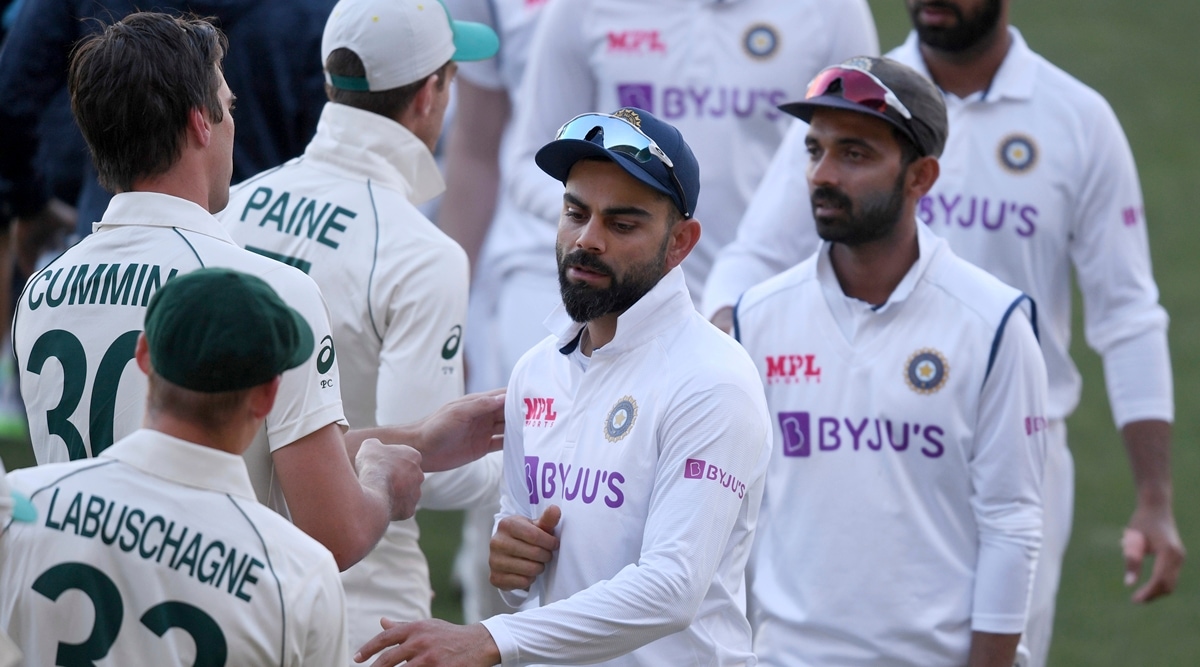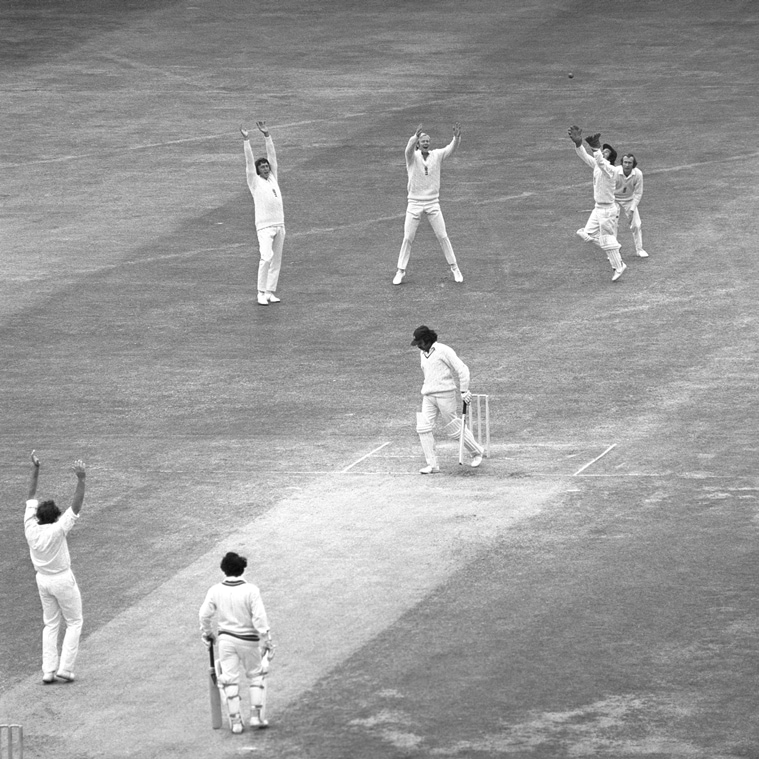![]()

Virat Kohli shakes hands with Australian players after the end of the Adelaide Test. (AP)
Both were swift and sudden. And in either case, the Indian fan certainly did not see them coming.
Lord’s, 1974. Adelaide, 2020.
42 all out the first time. 36 all out the second.
Mind you, there are those who will insist that both scoreboards are not strictly accurate — it was actually 42-9 and 36-9. For, Bhagwat Chandrasekhar did not bat in the second innings at Lord’s, being injured, and Mohammad Shami retired hurt at Adelaide in 2020.
EXPLAINED | Is ‘Summer of 36’ Team India’s lowest point?
Did anyone see it coming?
That is not the only coincidence in the two (in)famous collapses. In both cases, India had arrived on tour being seen as a very competitive side – in 1974, the Wadekar-lead Indian team had won three series in a row in 1971 in the West Indies and England, and 1972-73 against England at home, and was known for having two of the best young batsmen around — Gavaskar and Vishwanath — and of course was famed for its spin prowess — Bedi, Prasanna, Chandrasekhar. And although the Indians lost the first Test at Manchester, they competed stubbornly right till the very end, with Gavaskar scoring what he considered to be his best Test century in the first innings. Even at Lord’s, they replied to England’s massive score of 629 with 302 in the first innings, and there were people who felt that a strong second innings response while following on could not be ruled out, especially as India returned to the pavilion on the third evening at 2 for no loss.
Similarly, the Indian team skippered by Virat Kohli arrived in Australia with impressive credentials and with some big names on board, including perhaps the best batsman in world cricket (Kohli himself, albeit only for part of the tour), the best bowler (Jaspreet Bumrah) and one of the world’s best all-rounders (Ravichandran Ashwin). And while Wadekar’s side had been reasonably competitive until the collapse at Lord’s, there was reason to believe that Kohli’s team was actually in control at Adelaide. When India went off the pitch at stumps on the second day, the score was 9 for 1, and notwithstanding all the memes and jokes generated by the dismissal of Prithvi Shaw (“He tried to commit suicide by standing in front of a bus, but lived, because the bus went between his bat and pad” and so on), the broad consensus was that India held the upper hand, as it had a first innings lead, nine batsmen to come and three days left to play.
At Lord’s on June 24, 1974, Gavaskar and Engineer walked in with the score at 2/0, determined to make England bat again and drag the match to another day at least. At Adelaide on December 19, Mayank Agarwal and night watchman Jaspreet Bumrah resumed at 9/1 with what many assured viewers was a vital first innings lead of 53 behind them.
And they all fell down…
Play got underway. And then the House of Cards effect kicked in. At both places. In the first session. So much so that the match was literally over in little more than an hour at one venue, and all over but for the shouting (and some rather basic batting) in the second.
The shock was much sharper at Lord’s, where Geoff Arnold and Chris Old got of to a flier from the word “play”. Engineer went without adding to the overnight score, and before people knew what was happening, Wadekar, Vishwanath and Brijesh Patel had joined him, leaving India tottering at 14-4. To their credit, Agarwal and Bumrah took the overnight score to 15-1, one run more than at Lord’s, before the storm hit.
LISTEN | Decoding the great Indian batting collapse in Adelaide
At Lord’s, all thoughts of surviving had been replaced by those of avoiding humiliation, as Gavaskar and Solkar got together took the score to 25. And then Gavaskar was trapped leg before, Abid Ali caught behind and Madan Lal caught in the field, as India dipped to 30 for 7. Some brisk hitting by Solkar, who top-scored with an unbeaten 18, took the score to 42, before Old cleaned up Prasanna and Bedi to leave India at 42-9, with Chandrasekhar unable to bat.
The shock to an extent was way greater at Adelaide. Agrawal and Bumrah had taken the score to 15. There was not that much concern when Bumrah was dismissed at that score – after all, he WAS the nightwatchman. But things changed when the score did not, even as Pujara, Agarwal (little did he know that his 9 would be the top score of the innings) and Rahane all departed — 15-1 became 15-5. Hope soared when Kohli got off the mark with a boundary and promptly crashed when he was dismissed with no further addition– 19-6. Hanuma Vihari played the Solkar for India, taking the score into the thirties with an 8, but when Mohammad Shami retired hurt at 36-9, the curtains came down on India’s lowest score in a completed Test innings.
Similarities and differences
There are some interesting similarities and differences between the two capitulations:
— In both cases, there were no extras.
— India had lasted 17 overs to score 42, and 21.2 overs to score 36.
— In both cases, the innings was over in less than a session. And in both cases, this was the morning, pre-lunch session.
— In both cases, only three bowlers were used by the opposition. And in both cases, one took five wickets, another four wickets, and one went wicketless. Chris Old got 5-21, Geoff Arnold 4-19 at Lord’s, while Mike Hendrick went wicketless. At Adelaide, Josh Hazelwood got a rather amazing 5-8, Pat Cummins got 4-21, while Mitchell Starc went wicketless.
— In both innings, well-known spinners did not get a bowl at all as seam and swing ran riot – Derek Underwood and Nathan Lyon! One all-rounder in each team also was considered surplus to bowling requirements – Tony Greig in 1974 and Cameron Green in 2020!
— In both innings, the batsmen managed to hit four fours. However, at Lord’s, Solkar also hit a six. Interestingly, the difference between 42 and 36 is… SIX!
![]()
 England players celebrating a wicket in the second Test of the series against India in 1974. (Source: Twitter/@ESPN)
England players celebrating a wicket in the second Test of the series against India in 1974. (Source: Twitter/@ESPN)
— Interestingly, five Indian batsmen at Lord’s got dismissed without any fielder involvement – two were leg before, and three were bowled. At Adelaide, only one player was bowled, and there were no leg befores at all, although Bumrah could claim to have been dismissed without an outfielder being involved – he was caught and bowled by Cummins. Incidentally, three were caught behind at Lord’s, and five at Adelaide.
— Four out of the 17 overs bowled at Lord’s at India were maidens, ten of the 21.2 overs bowled at Adelaide were runless. Were India more aggressive in 1974 or did Solkar’s late sally change figures a little?
— Just two Indians got ducks at Lord’s. Three did at Adelaide. Incidentally, four batsmen got to five and beyond at Lord’s. Just two did at Adelaide. More “starts” (of sorts) in 1974.
— Eknath Solkar top-scored at Lord’s with 18 not out. Mayank Agarwal did so at Adelaide with exactly half the score – 9. Interestingly, the longest innings were played by openers in both cases – Gavaskar lasted 26 deliveries and 49 minutes for 5 at Lord’s while Mayank Agarwal consumed 40 deliveries and 57 minutes for his 9 at Adelaide.
READ | India vs Australia: All the grim numbers from Adelaide Test
— Of the 20 batsmen who batted at Lord’s and Adelaide, 19 got dismissed in single figures (Solkar was the only one to get past 10). However, and this is curious, no one scored 6 or 7 – five scored 0, one scored 1, two scored 2 (oh the symmetry), two also scored 3, four scored 4 (all at Adelaide), three scored five (all at Lord’s), one scored 8 and one scored 9.
— A final and very interesting coincidence, the final day of the Test of Lord’s was supposed to be June 25. Of course, play did not go into the final day after India’s collapse. But nine years later, on June 25, 1983, at Lord’s, India won the World Cup.
Just like at Lord’s in 1974, Adelaide in 2020 also did not go into the final day, which would have been December 21, 2020. Perhaps, India will do something amazing on December 21, 2029.
Hope springs eternal. And well, the only way is up from 36. Mind you, that’s what they said about 42 in 1974.
© IE Online Media Services Pvt Ltd


